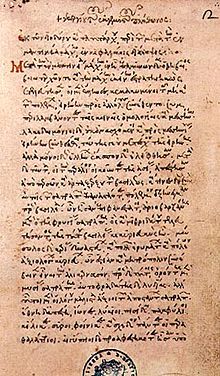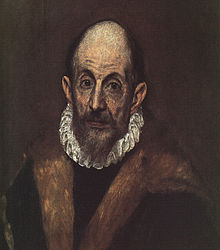Greek scholars in the Renaissance


The migration of Byzantine scholars and other émigrés from southern Italy and Byzantium during the decline of the Byzantine Empire (1203-1453) and mainly after the fall of Constantinople in 1453 until the 16th century, is considered by some scholars as very important in the revival of Greek and Roman studies and subsequently in the development of the Renaissance humanism.[1] These emigres were grammarians, humanists, poets, writers, printers, lecturers, musicians, astronomers, architects, academics, artists, scribes, philosophers, scientists, politicians and theologians.[2].
Their main role within the Renaissance humanism was mainly the teaching of the Greek language to their western counterparts in universities or privately together with the spread of ancient texts and sciences. Also they were teaching Greek philosphy, arts and sciences, scholarly techniques such as the Byzantine schedographia and they were translating Greek texts to Latin [3]. Their forerunners were the southern Italians Barlaam of Calabria (Bernardo Massari) and Leonzio Pilato, whose impact on the very first Renaissance humanists was indisputable [4] .
Collegio Pontifico Greco was a foundation of Gregory XIII, who established a college in Rome to receive young Greeks belonging to any nation in which the Greek Rite was used, and consequently for Greek refugees in Italy as well as the Ruthenians and Malchites of Egypt and Syria. These young men had to study the sacred sciences, in order to spread later sacred and profane learning among their fellow-countrymen and facilitate the reunion of the schismatical Churches. The construction of the College and Church of S. Atanasio, joined by a bridge over the Via dei Greci, was begun at once. The same year (1577) the first students arrived, and until the completion of the college were housed elsewhere [5].
Besides the southern Italians who inhabited ex-Byzantine territories of the peninsula which, in part, were still Greek-speaking and connected with the Byzantine culture, by 1500 there was a Greek community of about 5,000 in Venice. The Venetians also ruled Crete and Dalmatia, where many refugees also settled. Crete was especially notable for the Cretan School of icon-painting, which after 1453 became the most important in the Greek world. [6]
Contribution of Greek scholars to the Italian Renaissance

Although ideas from ancient Rome already enjoyed popularity with the scholars of the fourteenth century and their importance to the Renaissance was undeniable, the lessons of Greek learning brought by Byzantine intellectuals changed the course of humanism and the Renaissance itself. While Greek learning affected all the subjects of the studia humanitatis, history and philosophy in particular were profoundly affected by the texts and ideas brought from Byzantium. History was changed by the re-discovery and spread of Greek historians’ writings, and this knowledge of Greek historical treatises helped the subject of history become a guide to virtuous living based on the study of past events and people. The effects of this renewed knowledge of Greek history can be seen in the writings of humanists on virtue, which was a popular topic. Specifically, these effects are shown in the examples provided from Greek antiquity that displayed virtue as well as vice. The philosophy of not only Aristotle but also Plato affected the Renaissance by causing debates over man’s place in the universe, the immortality of the soul, and the ability of man to improve himself through virtue. The flourishing of philosophical writings in the fifteenth century revealed the impact of Greek philosophy and science on the Renaissance. The resonance of these changes lasted through the centuries following the Renaissance not only in the writing of humanists, but also in the education and values of Europe and western society even to the present day[7][8][9].
Deno Geanakopoulos in his work on the contribution of Greek scholars to Renaissance has summarised their input into three major shifts to Renaissance thought: 1) In early 14th century Florence from the early, central emphasis on rhetoric to one on metaphysical philophy by means of introducing and reintepretation of the Platonic texts, 2) In Venice-Padua by reducing the dominance of Averroist Aristotle in science and philosphy by supplementing but not completely replacing it with Byzantine traditions which utilised ancient and Byzantine commentators on Aristotle, 3) and earlier in the mid 15th century in Rome, through emphasis non on any philosophical school but through the production of more authentic and reliable versions of Greek texts relevant to all fields of humanism and science and with respect to the Greek fathers of the church. Hardly less important was their direct or indirect influence on exegesis of the New Testament itself through Bessarion's inspiration of Lorenzo Valla's biblical emendations of the Latin vulgate in the light of the Greek text [10]. .
List of renowned Byzantine scholars


- Manuel Chrysoloras -Florence, Pavia, Rome, Venice, Milan
- George Gemistos Plethon -Teacher of Bessarion
- Bessarion
- George of Trebizond -Venice, Florence, Rome
- Theodorus Gaza -First dean of the University of Ferrara, Naples and Rome
- John Argyropoulos -Universities of Florence, Rome
- Laonicus Chalcocondyles
- Demetrius Chalcondyles -Milan
- Theofilos Chalcocondylis -Florence
- Constantine Lascaris -University of Messina
- Henry Aristippus
- Michael Apostolius -Rome
- Aristobulus Apostolius
- Arsenius Apostolius
- Demetrius Cydones
- Janus Lascaris or Rhyndacenus -Rome
- Maximus the Greek studied in Italy before moving to Russia
- Ioannis Kottounios -Padua
- Konstantinos Kallokratos
- Barlaam of Seminara - He thaught Petrarch some rudiments of Greek language
- Marcus Musurus -University of Padua
- Michael Tarchaniota Marullus -Ancona and Florence, friend and pupil of Jovianus Pontanus
- Leo Allatius -Rome, librarian of the library of Vatican
- Demetrios Ducas
- Leozio Pilatus - He taught Boccacio some rudiments of Greek language

- Maximus Planudes -Rome, Venice
- Leonard of Chios -Greek-born Roman Catholic prelate
- Simon Atumano -Bishop of Gerace in Calabria
- Isidore of Kiev
- Elia del Medigo -Venice
- George Hermonymus -University of Paris, teacher of Erasmus, Reuchlin, Budaeus and Jacques Lefèvre d'Étaples
- John Chrysoloras -scholar and diplomat: relative of Manuel Chrysoloras, patron of Francesco Filelfo
- Andronicus Contoblacas -Basel, teacher of Johann Reuchlin
- John Servopoulos -Reading, Oxford; scholar, professor
- Johannes Crastonis Modena, Greek-Latin dictionary
- Andronicus Callistus -Rome
- Gerasimos Vlachos -Venice
- George Amiroutzes -Florence, Aristotelian
- Gregory Tifernas -Paris teacher of Jacques Lefèvre d'Étaples and Robert Gaguin
- Nikolaos Sophianos -Rome, Venice: scholar and geographer, creator of the Totius Graeciae Descriptio

- Zacharias Calliergi -Rome
- Mathew Devaris -Rome
- Antonios Eparchos -Venice, scholar and poet
- Maximos Margunios -Venice
- Mathaeos Kamariotis
- Nikolaos Loukanis -Venice
- Iakovos Trivolis-Venice
- Janus Plousiadenos -Venice, hymnographer and composer
- Nicholas Leonicus Thomaeus - Venice- Padua
Printers, Artists & Patrons

- El Greco -Cretan painter, Italy, Spain
- Antonio Vassilacchi - painter from Milos worked in Venice with Paolo Veronese
- Michael Damaskenos -Venice, Cretan painter
- Francisco Leontaritis -Italy, Bavaria: singer and composer
- Anna Notaras -Venice, first Greek typing press
- Thomas Flanginis -Venice, funded the establishment of the Flanginian Greek school for teachers
- Angelos Pitzamanos (1467-1535) Cretan painter Otranto, South Italy [11]
- Emmanuel Tzanes -Venice, Cretan painter
- Theodore Poulakis -Venice, painter
- John Rhosos -Rome, Venice well-known scribe
See also
- Byzantine art
- Cretan School
- Byzantine science
- List of Byzantine scientists
- Renaissance humanism
- Arab transmission of the Classics to the West
References
- ^ Byzantines in Renaissance Italy
- ^ Greeks in Italy
- ^ Constantinople and the West by Deno John Geanakopulos- Italian Renaissance and thought and the role of Byzantine emigres scholars in Florence, Rome and Venice: A reassessment University of Wiskonshin Press, 1989
- ^ The Italian renaissance in its historical background, Denis Hay Cambridge University Press 1976
- ^ De Meester, "Le Collège Pontifical Grec de Rome", Rome, 1910
- ^ Maria Constantoudaki-Kitromilides in From Byzantium to El Greco,p.51-2, Athens 1987, Byzantine Museum of Arts
- ^ From Byzantium to Italy: Greek Studies in the Italian Renaissance. by N. G. Wilson The Sixteenth Century Journal, Vol. 25, No. 3 (Autumn, 1994), pp. 743-744
- ^ Eight philosphers of the Italian rennaissance, Paul Oscar Kristeller Stanford University Press,1964
- ^ Constantinople and the West by Deno John Geanakopulos- Italian Renaissance and thought and the role of Byzantine emigres scholars in Florence, Rome and Venice: A reassessment University of Wiskonshin Press, 1989
- ^ Constantinople and the West by Deno John Geanakopulos- Italian Renaissance and thought and the role of Byzantine emigres scholars in Florence, Rome and Venice: A reassessment University of Wiskonshin Press, 1989
- ^ Nano Chatzidakis: The character of the Velimezis Collection
Sources
- Deno J. Geanakoplos, Byzantine East and Latin West: Two worlds of Christendom in Middle Ages and renaissance. The Academy Library Harper & Row Publishers, New York, 1966.
- Deno J Geanakoplos, (1958) A Byzantine looks at the renaissance, Greek, Roman and Byzantine Studies 1 (2);pp:157-62.
- Jonathan Harris, Greek Émigrés in the West, 1400-1520, Camberley: Porphyrogenitus, 1995.
- Louise Ropes Loomis (1908) The Greek Renaissance in Italy The American Historical Review, 13(2);pp:246-258.
- John Monfasani Byzantine Scholars in Renaissance Italy: Cardinal Bessarion and Other Émigrés: Selected Essays, Aldershot, Hampshire: Variorum, 1995.
- Steven Runciman, The fall of Constantinope, 1453. Cambridge University press, Cambridge 1965.
- Fotis Vassileiou & Barbara Saribalidou, Short Biographical Lexicon of Byzantine Academics Immigrants to Western Europe, 2007.
- Dimitri Tselos (1956) A Greco-Italian School of Illuminators and Fresco Painters: Its Relation to the Principal Reims Manuscripts and to the Greek Frescoes in Rome and Castelseprio The Art Bulletin, 38(1);pp: 1-30.
External links
- Greece: Books and Writers.
- Michael D. Reeve, "On the role of Greek in Renaissance scholarship.'
- Jonathan Harris, 'Byzantines in Renaissance Italy'.
- Bilingual (Greek original / English) excerpts from Gennadios Scholarios' Epistle to Orators.
- Paul Botley, Renaissance Scholarship and the Athenian Calendar.
- Richard C. Jebb 'Christian Renaissance'.
- Karl Krumbacher: 'The History of Byzantine Literature: from Justinian to the end of the Eastern Roman Empire (527-1453)'.
- San Giorgio dei Greci and the Greek community of Venice
- Istituto Ellenico di Studi Byzantini and Postbyzantini di Venezia
